Casting in Resin for Model Railways.
Nick Coppin.
There are a number of reasons to want to make cast items for model railways. It may be to save money compared to buying commercially available parts. It might be that the parts required are not available or it might just be for fun!
I model in two scales: 16mm to the foot (two foot gauge on 32mm track) and 15mm to the foot (three foot gauge on 45mm track). There are few items available in the latter scale. I specifically wanted some wagon wheels for Southwold Railway wagons and coaches. These were six split spoke wheels.
I was able to buy ready machined tyres of the correct diameter from Slaters Plastikard. For the centres, I had a master laser cut in steel which I machined to be a comfortable fit in the Slaters tyre.
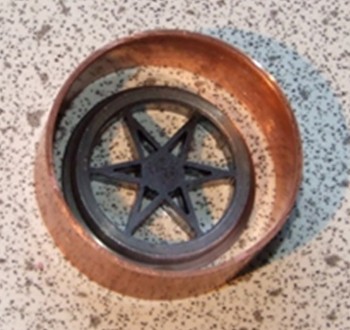 Pattern wheel and the copper pipe for forming the mould in.
Pattern wheel and the copper pipe for forming the mould in.
At the 2013 Guildex, I spoke to Hobby Holidays about casting and they sold me some silicone moulding rubber and some polyurethane casting resin. To make the mould, I stuck the wheel master with its Slaters tyre onto a piece of laminate and carefully positioned a ring made from copper pipe around it. You are supposed to leave at least 5mm for wall thickness.
Using digital kitchen scales, I mixed the mould material according to the instructions and 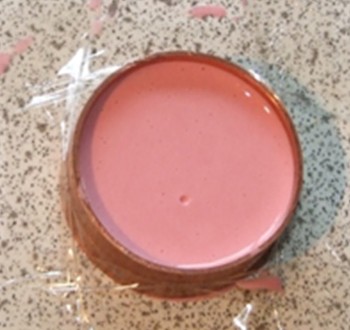 The mould being cast.carefully poured it into the copper pipe. With a cocktail stick, I poked around in the small spaces in the wheel to ensure trapped air could escape and tapped the mould to encourage bubbles to rise to the top before it started to go off.
The mould being cast.carefully poured it into the copper pipe. With a cocktail stick, I poked around in the small spaces in the wheel to ensure trapped air could escape and tapped the mould to encourage bubbles to rise to the top before it started to go off.
You are encouraged to leave it to cure for 24 hours but I got a bit bored after about 15 hours
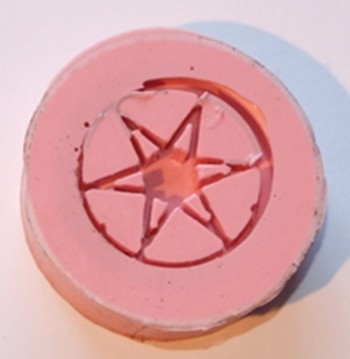 The extracted mould ready for use.
The extracted mould ready for use.
and peeled it gently away from the copper pipe and steel centre and tyre.
Because I am making wheels,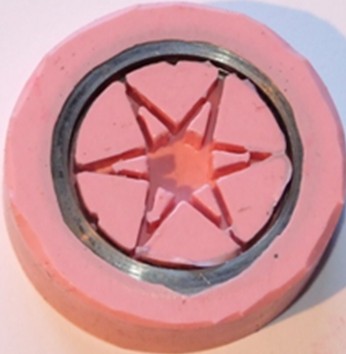 Rim in mould ready to be filled wth resin. I fitted a tyre into the mould ready for the resin to be cast inside it.
Rim in mould ready to be filled wth resin. I fitted a tyre into the mould ready for the resin to be cast inside it.
The polyurethane casting resin is mixed in equal quantities, stirred for 30 seconds and poured into the silicone mould. Again, it is important to wield the cocktail stick to dislodge any bubbles but you only have less than a minute to do this. It is useful to have a spare mould to use up any excess resin though I gather you can partly fill moulds and top them up later.
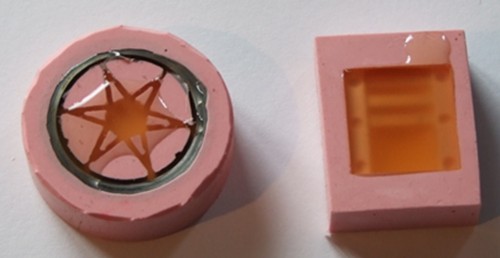 Filled mould and coupling mould.
Filled mould and coupling mould.
This is the wheel mould filled and a buffer/coupling casting for a narrow gauge diesel loco using up the excess resin.
After an hour or so, the cured casting can be removed from the mould.
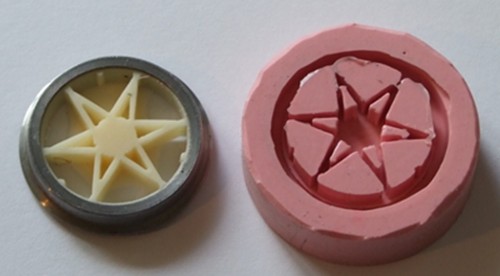 Wheel extracted from the mould.
Wheel extracted from the mould.
The back of the wheel is gently rubbed against a piece of glass paper glued to a board and then finally flattened with emery paper glued to a board. 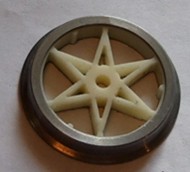 Finished machined wheel ready to be mounted on axle. Mounted on a mandrel in the lathe, the tyre is set to run true and the centre drilled for the axle.
Finished machined wheel ready to be mounted on axle. Mounted on a mandrel in the lathe, the tyre is set to run true and the centre drilled for the axle.